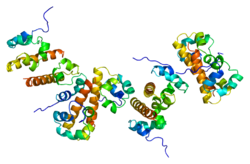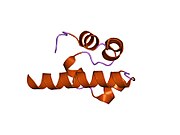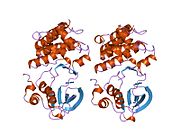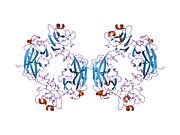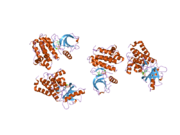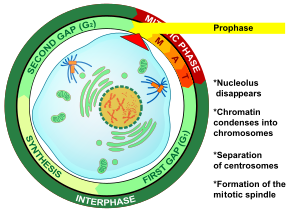EPH 수용체 B2
EPH receptor B2에프린 타입-B 수용체 2는 인간에서 EPHB2 유전자에 의해 암호화된 단백질이다.[5]
함수
에프린 수용체와 그들의 리간드인 에프린은 특히 신경계에서 수많은 발달 과정을 중재한다.에프린은 그 구조와 염기서열 관계를 바탕으로 글리코실인스포시디틸리노시톨 연계에 의해 막에 고정되어 있는 에프린-A(EFNA) 등급과 투과단백질인 에프린-B(EFNB) 등급으로 나뉜다.수용체 Eph 계열은 세포외 영역 시퀀스의 유사성과 에프린-A와 에프린-B 리간드를 결합하는 친화력을 바탕으로 2개 그룹으로 나뉜다.에프린 수용체는 수용체 티로신키나아제(RTK) 계열 중 가장 큰 부분군을 구성한다.이 유전자가 인코딩한 단백질은 에프린-B 계열의 수용체다.[6]
동물학
EphB2는 NMDA 신호 전달 경로의 일부로서, 표현을 복원하면 알츠하이머병의 동물 모델에서 인지 기능을 구조한다.[7]
열성 EphB2 유전자는 비둘기의 볏모자 돌연변이를 일으킨다.[8]
상호작용
EPH 수용체 B2는 다음과 상호작용하는 것으로 나타났다.
참조
- ^ a b c GRCh38: 앙상블 릴리스 89: ENSG00000133216 - 앙상블, 2017년 5월
- ^ a b c GRCm38: 앙상블 릴리스 89: ENSMUSG000028664 - 앙상블, 2017년 5월
- ^ "Human PubMed Reference:". National Center for Biotechnology Information, U.S. National Library of Medicine.
- ^ "Mouse PubMed Reference:". National Center for Biotechnology Information, U.S. National Library of Medicine.
- ^ Chan J, Watt VM (August 1991). "eek and erk, new members of the eph subclass of receptor protein-tyrosine kinases". Oncogene. 6 (6): 1057–61. PMID 1648701.
- ^ "Entrez Gene: EPHB2 EPH receptor B2".
- ^ Cissé M, Halabisky B, Harris J, Devidze N, Dubal DB, Sun B, Orr A, Lotz G, Kim DH, Hamto P, Ho K, Yu GQ, Mucke L (January 2011). "Reversing EphB2 depletion rescues cognitive functions in Alzheimer model". Nature. 469 (7328): 47–52. Bibcode:2011Natur.469...47C. doi:10.1038/nature09635. PMC 3030448. PMID 21113149.
- "Protein provides Alzheimer's clue". NHS Choices. November 29, 2010. Archived from the original on 2011-05-18.
- ^ Shapiro MD, Kronenberg Z, Li C, Domyan ET, Pan H, Campbell M, Tan H, Huff CD, Hu H, Vickrey AI, Nielsen SC, Stringham SA, Hu H, Willerslev E, Gilbert MT, Yandell M, Zhang G, Wang J (January 2013). "Genomic diversity and evolution of the head crest in the rock pigeon". Science. 339 (6123): 1063–7. Bibcode:2013Sci...339.1063S. doi:10.1126/science.1230422. PMC 3778192. PMID 23371554.
- Carl Zimmer (February 4, 2013). "Pigeons Get a New Look". The New York Times.
- ^ Yu HH, Zisch AH, Dodelet VC, Pasquale EB (July 2001). "Multiple signaling interactions of Abl and Arg kinases with the EphB2 receptor". Oncogene. 20 (30): 3995–4006. doi:10.1038/sj.onc.1204524. PMID 11494128.
- ^ Holland SJ, Gale NW, Gish GD, Roth RA, Songyang Z, Cantley LC, Henkemeyer M, Yancopoulos GD, Pawson T (July 1997). "Juxtamembrane tyrosine residues couple the Eph family receptor EphB2/Nuk to specific SH2 domain proteins in neuronal cells". EMBO J. 16 (13): 3877–88. doi:10.1093/emboj/16.13.3877. PMC 1170012. PMID 9233798.
- ^ Zisch AH, Kalo MS, Chong LD, Pasquale EB (May 1998). "Complex formation between EphB2 and Src requires phosphorylation of tyrosine 611 in the EphB2 juxtamembrane region". Oncogene. 16 (20): 2657–70. doi:10.1038/sj.onc.1201823. PMID 9632142.
- ^ Zisch AH, Pazzagli C, Freeman AL, Schneller M, Hadman M, Smith JW, Ruoslahti E, Pasquale EB (January 2000). "Replacing two conserved tyrosines of the EphB2 receptor with glutamic acid prevents binding of SH2 domains without abrogating kinase activity and biological responses". Oncogene. 19 (2): 177–87. doi:10.1038/sj.onc.1203304. PMID 10644995.
이 기사는 공공영역에 있는 미국 국립 의학 도서관의 텍스트를 통합하고 있다.
